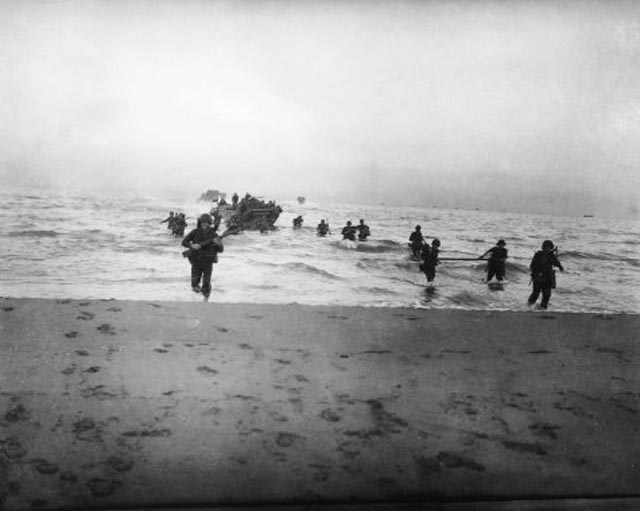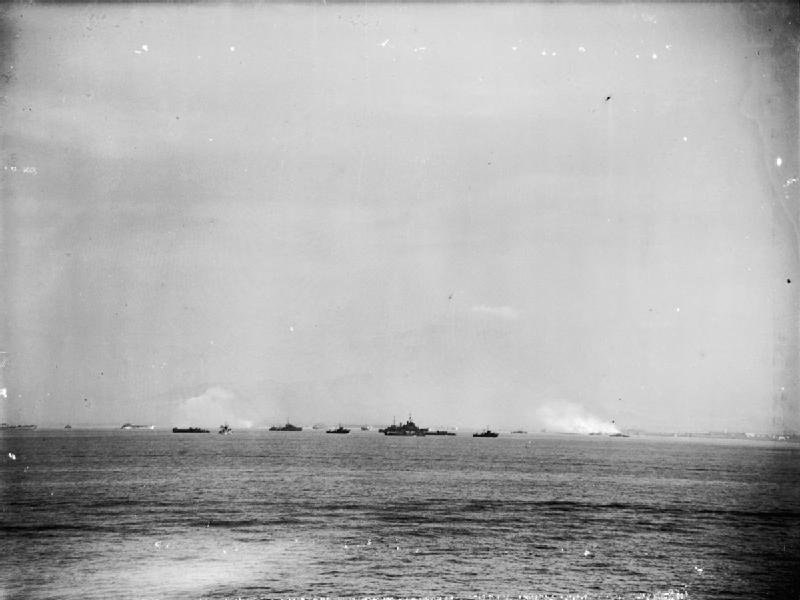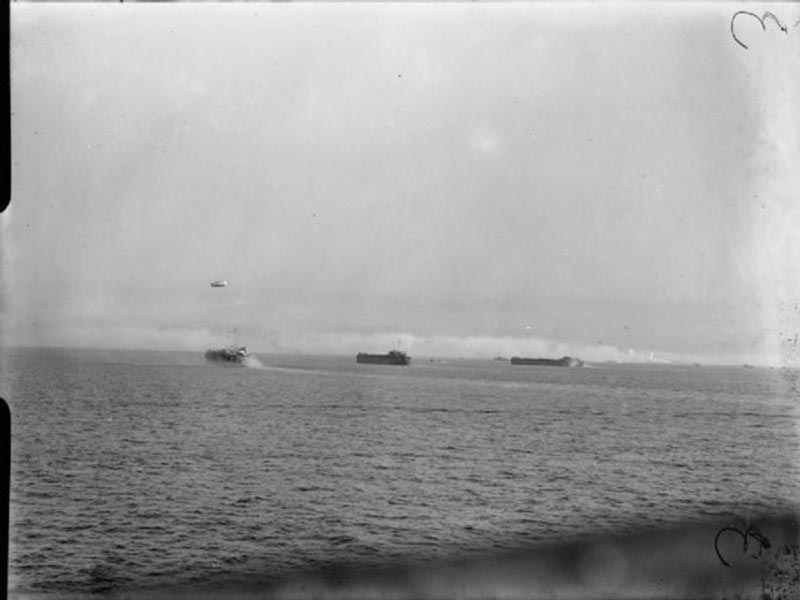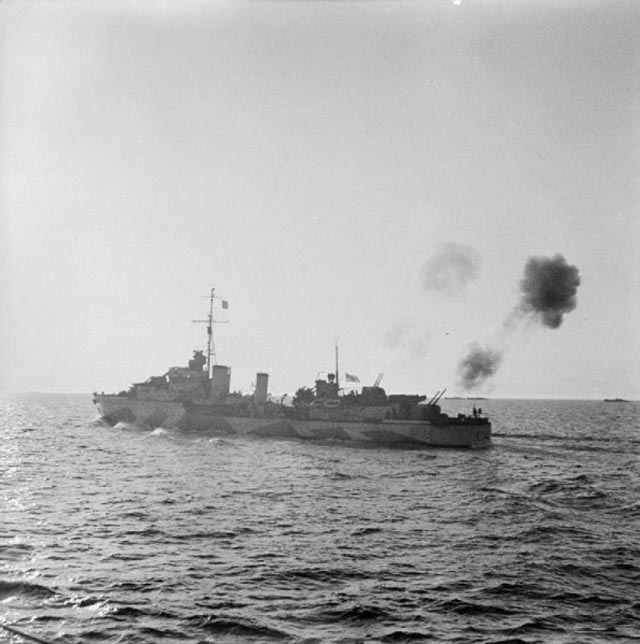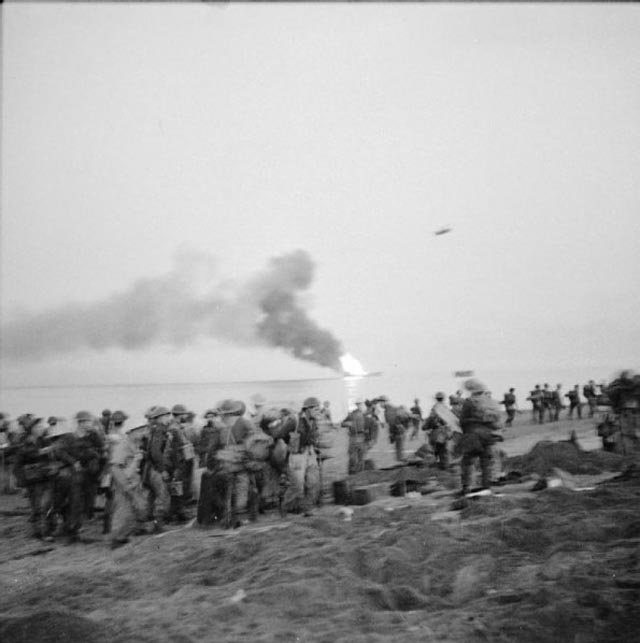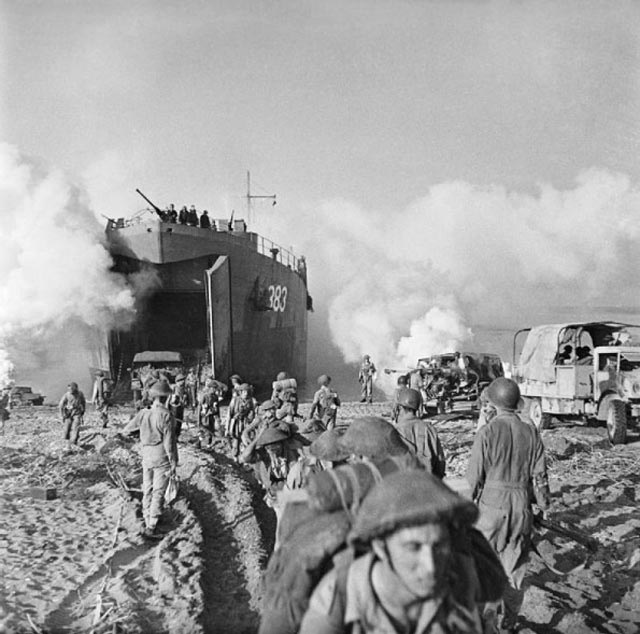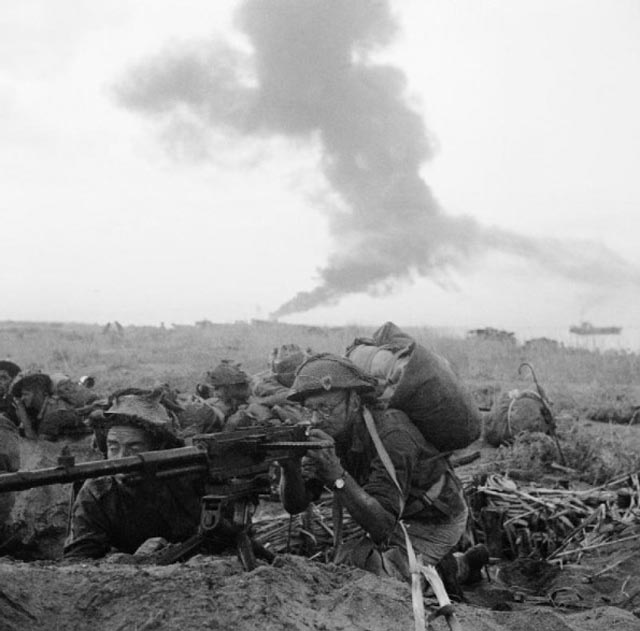Air Operations, Bismarcks
V Bomber Command B-24s attack Garove Island. B-25s attack coastal targets on New Britain.
[Air Operations, CBI
CHINA- 8 11th Medium Bomb Squadron B-25s and 11 23rd Fighter Group P-40s attack the White Cloud airfield at Canton.
- 4 449th Fighter Squadron P-38s attack the dock area at Whampoa.
- 8 P-40s and P-38s attack Yangtze River traffic.
- 74th Fighter Squadron P-40s down 3 A6M Zeros over the White Cloud airfield at Canton during a noon-hour mission and a 449th Fighter Squadron P-39 downs a transport plane near Whampoa at 1530 hours.
Air Operations, East Indies
V Bomber Command B-25s mount light attacks against Selaroe Island in the Moluccas.
[Air Operations, Europe
US 8th AIR FORCEFRANCE:
- Between 0830 and 0840 hourst, 1st Bomb Division B-17s seed Lille/Nord, Lille/Vendeville, and Vitry-en-Artois Airdromes with thousands of 20-pound frangmentation bombs designed to damage airplanes, buildings and equipment.
- 4 2nd Bomb Division B-24 groups attack the Abbeville/Drucat, St.-Omer/Ft. Rouge, and St.-Omer/Lounguenesse Airdromes with general-purpose and fragmentation bombs.
- 20 of 87 3rd Bomb Division B-17s briefed to attack an aircraft plant in Paris do so at 0903 hours while 48 B-17s divert to a secondary target, the Beaumont-sur-Oise Airdrme, between 0855 and 0916 hours.
- 59 3rd Bomb Division B-17s attack the Beauvais/Tille Airdrome about 0815 hours.
- 215 P-47s escorting the heavy-bomber attacks claim just 1 Luftwaffe FW-190 near Beauvais at 0817 by a 56th Fighter Group P-47.
- 202 3rd Medium Bomb Wing B-26s drop more than 334 tons of bombs on coast-defense positions around Boulogne between 0745 and 0915 hours.
- 3 B-26s are lost, 18 damaged; 11 crewmen killed, 8 wounded, 19 missiong
ITALY:
- IX Bomber Command B-24s attack the Foggia satellite fields.
- XII Bomber Command B-17s attack bridges at Cancello Arnone and Capua.
- More than 240 B-25 and B-26 sorties are mounted against rail bridges at Potenza and the landing ground at Scanzano.
- NATAF aircraft patrol over the landing beaches, provide on-call air support against all manner of tactical targets, and mount sweeps against motor vehicles and other targets of opportunity.
- During the course of hundreds of fighter sorties, only 3 Luftwaffe aircraft are engaged. 1 Do-217 bomber is damaged by a 325th Fighter Group P-40 during a morning mission. 1 FW-190 and 1 Fi-156 are downed by 86th Fighter Group A-36s, also during the morning.
Air Operations, New Guinea
V Bomber Command B-25s attack coastal targets between Alexishafen and Finschhafen.
[Air Operations, Solomons
- 18 XIII Bomber Command B-24s attack the Kahili airfield on Bougainville and 2 coastal batteries.
- 12 AirSols B-25s and more than 50 SBDs attack the Vila airfield on Kolombangara and barges in the area.
- 2 Marine Corps F4Us down an A6M Zero between Vella Lavella and Choiseul at 0955 hours. A VF-33 F6F downs a Zero over Kahili at 0955 hours.
Balkans
The Germans take over direct control of Croatia, Greece and the coasts and islands of Yugoslavia.
[Corsica
The Italian Cremona and Friuli Divs drive off the Germans at Bastia.
[Diplomatic Relations
Iran declares war on Germany.
[Eastern Front
Advancing westward beyond Konotop, the Soviets cross the Seym River and take Bakhmach after a brisk fight. Further north they reach the Desna River south of Bryansk. The German 17th Army begins to pull out of its forward position in the Kuban.
SOUTHERN SECTORThe 60th Army reaches Bachmakh, taking the town after a brief stuggle. In the Kuban the 17th Army begins its evacuation, pulling out of its forward positions to the Gotenkopf line.
[Italy
There is some fighting in the Rome area between Italian and German troops but the Italian plans have not been well-prepared and the government has to leave the city, allowing the Germans to take over. The Italian Royal Family and some representatives of the Italian government, with the Chiefs of Staff of the 3 armed forces, leave Rome for Pescara, from which they later sail aboard the cruiser Scipione to Brindisi.
In Rome the anti-Fascist parties set up the Committee of National Liberation.
At 0330 the Allies begin landing at Salerno and Taranto. In Operation SLAPSTICK the British 1st Airborne Div lands by sea at Taranto and seizes the port without opposition but the main landings at Salerno are more difficult. The landing forces are from Gen Mark Clark's 5th Army. On the left flank groups of US Rangers and British Commandos land respectively at Maiori and Vietri, with orders to advance north and capture passes throught the hills toward Naples. Both landings are successful. The British X Corps under Gen Sir Richard L. McCreery, made up of 46th and 56th Divs, lands on the beaches immediately to the south of Salerno. There are some mistakes made and German resistance is strongest here but the troops manage to get ashore fairly well. The Southern Assault Force is taken from Gen Ernest J. Dawley's VI US Corps with the 36th Div forming the first wave and landing north and south of Paestum. American losses on the approach are fairly heavy because they adhere more strictly than the British to Clark's order that there is to be no supporting bombardment. Once they land, however, the resistance is less intense.
The landings at Taranto are covered by Adm Sir Arthur Power with the battleships Howe and King George V and an Allied cruiser squadron led by Commodore Sir William G. Agnew. The Salerno landings are much more complex. Adm Andrew Cunningham commands the whole operaton and the main covering force is led by Adm Sir Algernon Willis with 4 battleships and 2 carriers. Adm Philip Vian leads a support group of 5 small carriers and Adm H. Kent Hewitt is in direct command of the landings.
In the south 8th Army continues to advance fairly slowly because of demolitions and poor roads.
A Do-217 sinks the battleship Roma with a Fritz X radio-controlled missile. 1,255 are killed including Adm Carlo Bergamini. German MTBs S-54 and S-61 lay mines in Taranto harbor which sink the HMS Abdiel on September 10. They then race to Venice sinking an Italian gunboat off Corsica and a destroyer and capture the troopship Leopardi en route and force the Italian naval commander at Venice to surrender.
[Mediterranean
The battleship Roma is sunk by a glider bomb launched from a German aircraft while en route to Malta with the main body of the Italian fleet. Several other ships are damaged by similar attacks. Adm Alberto da Zara sails from Taranto with the battleships Andrea Doria and Caio Duilio as well as other vessels.
[New Guinea
The Australians manage to force some small units across the Busu River and establish a bridgehead on the opposite bank. Japanese counter-attacks are repulsed.
[Pacific
- The US submarine Grayling (SS-209) is sunk in the South China Sea west of Luzon, possibly after being rammed by the Japanese transport Hokuan Maru.
- The US submarine Harder (SS-257) sinks the Japanese merchant cargo ship Koyo Maru (3010t).
Solomons
Adm Halsey suggests occupation of the Treasury Islands and part of Choiseul, which could serve as bases to neutralize the Japanese bases in the Shortland Islands and southern part of Bougainville. MacArthur turns the suggestion down
another example of the conflict of strategy between the American army and navy.
On Arundel Island the Americans hold up the activities of their infantry, but pound the enemy positions with their guns.
[Pics from September 9, 1943
|
|
|
|
|
|
|
|
|
|
